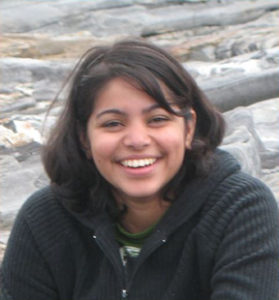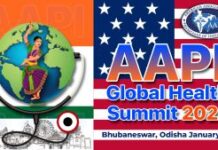
Dr. Anusha Sehgal, BAMS. MD (Ayurveda), presented a brilliant and educational talk on, ‘Metal Toxicity and the Controversy Surrounding Ayurveda’ on 13th July in at MIT, Cambridge. She said that in the recent times, some of the traditional Ayurvedic therapies and practices have been globalized, modernize ,and integrated in complementary or alternative medicine and general wellness despite some of the controversies surrounding Ayurveda.
Dr. Anusha’s journey from USA to India to become an Ayurvedic doctor and back to USA to practice Ayurvedic medicine is an inspirational one. “I was born and brought up here in Massachusetts. As most of the Indian young high school girls, I used to dream about becoming a doctor, but the some of the controversies surrounding Ayurvedic medicines in the media that time created a strong interest in me to go to India to get trained as an Ayurvedic doctor.
Because, my father and I thought that this medical system would not have survived for such a long time if Ayurvedic medicines have not had any curative or healing results. Now, I am teaching Ayurveda in many medical colleges of Massachusetts, Rode Island, and New York.” says Dr. Anusha, who is a fully trained Ayurvedic doctor in America.
“Welcome to Ayurveda Medicine World” says Dr. Anusha in a successful voice that fills the room with her electrifying energy. She talked very elaborately about its history and ambiguity in the interpretation of names and description of drugs found in the books, such as Charaka Samhita, Sushruta Samhita and other books. Original Ayurvedic treatises are in Sanskrit and also hand written.
Western scientists of the nineteenth century were divided in respect of the utility of Ayurveda: some scholars were of the opinion that this old system of medicine is based on empiricism rather than science and no benefit can be derived from it, whereas some others argue that Ayurveda uses scientific approaches as it is built by the rationale of observation, experiment, and of induction and deduction.
Now, U.S. National Center for Complementary and Alternative Medicine also says that Ayurvedic medicine combines the use of numerous modalities, such as herbal medicine, massage and special diets, to promote wellness and prevent illness. There are broadly two common practices in Ayurveda: herbal medicine alone or herbal medicines combined with metals and gems, a practice known as Rasa Shastra.
In rasa Shastra, herbs are combined with metals such as lead, mercury, iron and zinc, and gems such as pearl. Those that practice this type of Ayurveda believe it is safe and therapeutic to use metal based medicines. But, sometimes, she feels these practices are seriously called into question due to the variations in the acceptable limits on the use of metals in medicines set by different countries.
Dr. Anusha also said that FDA has not currently set a maximum level allowed for lead, mercury and arsenic in dietary supplements. In herbal medicines, due to lack of scientific names in the original texts, under one name, different plants are known in different parts of the country as per the description, which makes the drug controversial as well.
Ayurveda suggests such medicines should be taken under strict prescription by a trained doctor and in small quantities with washout periods in between if repetition of medicine required. It is not the Ayurveda or Ayurvedic medicines but the over or under dosing and longtime use of such medicines without a washout period and without a prescription written by a trained doctor by patients in the Western word lead to some recent controversies as well- she said confidently.
Dr. Anusha talked in detail about how ancient cultures utilized metals as medicines, controlled toxicity of metals through purification processes, and pharmaceutics of Ayurveda. She gave a very convincing and scientific presentation on her field of research, Rasa Shastra (science of Alchemy), especially about the Naga Bhasma – a medicine made of lead. She narrated the general purification of metals, liquids used in the purification, specialized purification of lead, Jarana of lead, incineration of lead and findings of Naga Bhasma as an end product.
She also engaged the audience for the whole time in a very informal and interactive discussion.
Q.How difficult was studying Ayurveda in India?
A. “Although the medium instruction in the Indian Ayurveda colleges is English, Ayurveda books use lots of Sanskrit words, definitions, Shlokas. So it was very challenging for me. I had to work harder to learn Sanskrit and understand the meanings of every Sanskrit word and to learn native languages of different states. I got lot of support from the teachers and friends to get through my training. I was happy and my studies went well as my family and I expected”
Q It is not often that Indian American children go to India to study Ayurveda and want to practice Ayurveda in America. How has the journey been?
A “My journey was not easy. It was always full of challenges and opportunities. I thoroughly enjoyed the journey. I work hard. I like Ayurveda and proud to be an Ayurvedic doctor in America. Sometimes I feel that I am not making that much money others are making but I never regret but teaching Ayurveda in the American well-known medical colleges like Harvard and Boston University and other colleges gives me immense satisfaction” says an enthusiastic Dr. Anusha with a bright big smile.
Q. How to overcome these controversies surrounding Ayurveda?
A. “There is a huge surge in Ayurvedic plant research for various aspects. There have also been substantial efforts to standardize the Ayurvedic crude drugs as well as finished Ayurvedic medicines.
The proper nomenclature of all crude drugs and establishing their exact botanical origin is a must because sometimes plants are collected by skilled but many a times by unskilled collectors and due to improper identification of correct species of plant/organ and collection methods lead to a state of confusion, and thus a controversies crop up. It is vital to generate parameters of identification as well as differentiation among different plant sources having a similar name.
These controversial sources sometimes lead to inefficacious preparation as well. Presently, some amount of legal sanction exists for use of plants as one can use only plant drugs mentioned in one of the 56 authorized books by Drugs and Cosmetic Act, 1940 of India. However, for global acceptance as well as providing safe and effective Ayurvedic products, it would be required to identify particular botanical entities to be used to have regulatory compliance.
Ayurvedic scholars, plant taxonomists, and regulators need to work together on this. Different countries around world need to work on standardizing acceptable limits of metals in the medicines instead setting their stands in isolation” says Dr. Anusha as few solutions.
Geetha Patil






